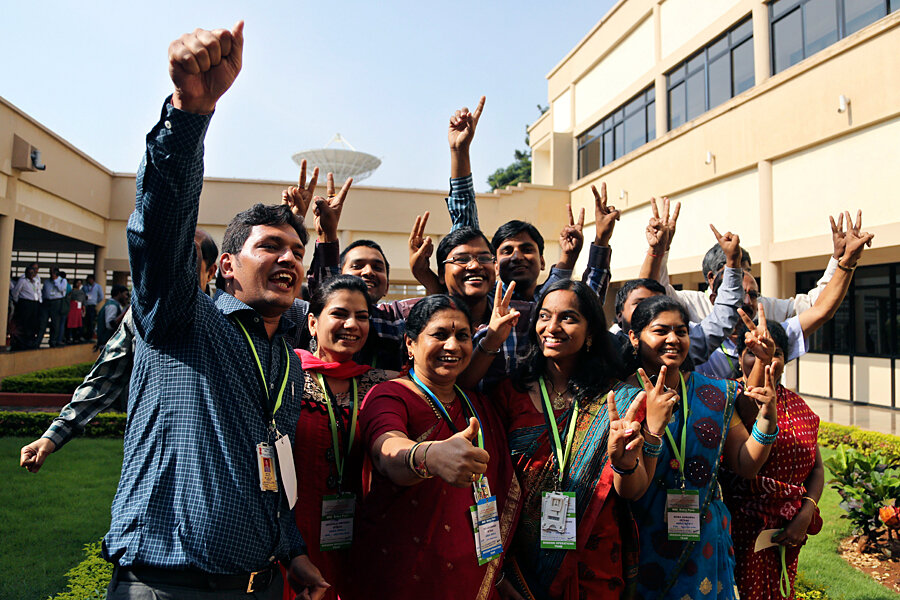With Mangalyaan, India is first in Asia to reach Mars
India became the first Asian nation to place a spacecraft in orbit around Mars Wednesday after its $75 million Mangalyaan orbiter reached the red planet and slowed itself sufficiently to allow Mars' gravity to capture it.
The Indian Space Research Organization (ISRO) joined the European Space Agency (ESA) as the only space programs to achieve the feat on their first try at exploring the fourth rock from the sun. ESA's first attempt came with the 2003 launch of its Mars Express mission, which consisted of a lander and orbiter. The lander failed, but the orbiter is still in action, returning data.
Given the track record of failures in reaching Mars or failure to achieve mission objectives once there during the past half century, India's achievement is notable – an observation not lost on the country.
Hindustan Times reported Indian Prime Minister Narendra Modi as saying, "History has been created by our scientists," in a speech delivered after the craft began orbiting Mars. "We have dared to reach out to the unknown."
After its 414 million-mile trip, Mangalyaan joins NASA's MAVEN orbiter, which arrived at Mars Sunday, in studying the Martian atmosphere. An ISRO objective is also to study the planet's surface.
One key measurement the Indian craft is designed to make focuses on methane. Methane can form from geological processes. But on Earth, some 90 percent of the methane in the atmosphere comes from biological activity.
ESA's Mars Express orbiter and ground-based observatories have detected varying amounts of methane in Mars' atmosphere, emissions that appear to come from three regions on the planet.
If the methane has a biological origin, it could come from extant organisms living deep underground or as fossil emissions from reservoirs of frozen methane produced by organisms that lived early in Mars' history, when the planet was more hospitable to life.
ESA plans to launch its ExoMars Trace Gas Orbiter in January 2016, which will hunt for methane and other trace gases in the Martian atmosphere and make measurements that could help distinguish biological from geological methane.
In the meantime, Mangalyaan is carrying an instrument that scientists will use to map the distribution of any methane it detects.
In addition, Mangalyaan carries a color camera and a spectrometer that will work in tandem to build maps of the distribution of minerals on the Martian surface. And it carries instruments that will complement the measurements that MAVEN will take to help scientists solve the mystery of Mars' vanishing atmosphere.
"The Indian Space Research Organization and NASA are quite interested in cooperating and correlating data sets," said Jim Green, who heads NASA's planetary science division in Washington, during a briefing previewing MAVEN's arrival.
"Those opportunities will open up" as the science teams for the two missions begin to understand their data, he said.
The oft-heard phrase "getting to Mars is hard" isn't just a cliché. Since 1960, 43 missions have set their sights on Mars via 42 launch attempts. Thirty-six percent of the missions succeeded.
China's first Mars mission, the Yinghou-1 orbiter, was launched on a Russian rocket in 2011 but never left Earth orbit. The United States is 15 for 20, its last failures coming in 1999 with the losses of the Mars Climate Orbiter and the Mars Polar Lander. Russia is 0 for 19, with its last failure coming in 2011 as well.
Mangalyaan was launched Nov. 5, 2013, 13 days before MAVEN's liftoff. Mangalyaan's orbit-insertion burn took 24 minutes, slowing the craft by some 9,400 miles an hour. The craft will orbit Mars once every 3.2 Earth days on a path that takes it from about 50,000 miles above the planet to within 263 miles of the surface.
If all goes well, Mangalyaan's primary mission will last six months.






